If you’re looking for a plant that’s both beautiful and deadly—at least to insects—sundews might be the perfect fit. These carnivorous plants are famous for their glistening, sticky tentacles that trap unsuspecting prey. With almost 200 species worldwide, sundews come in various shapes and sizes. In this blog, we’ll explore 25 unique types, divided into five fascinating categories.
Contents
Temperate Sundews
These sundews thrive in cooler climates and go dormant during winter.
Drosera rotundifolia (Round-leaved Sundew)
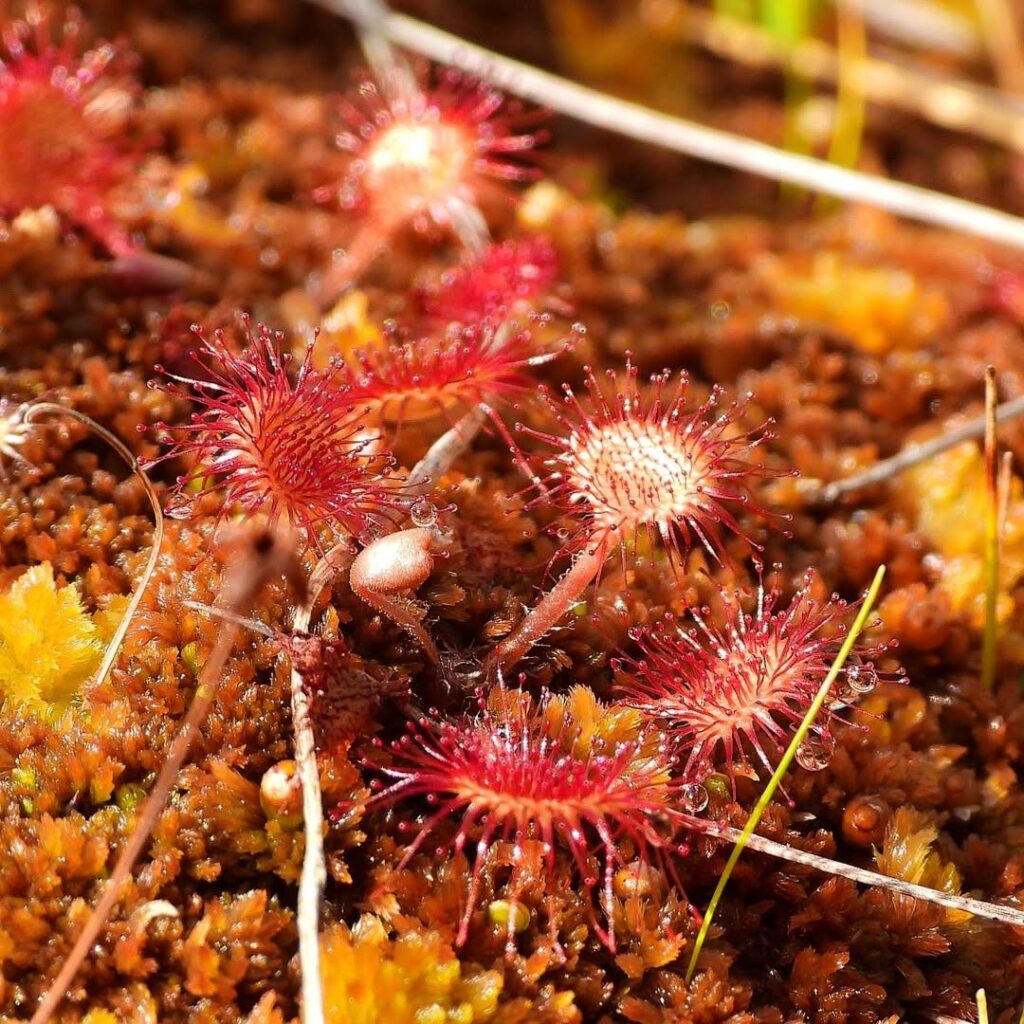
This sundew is one of the most widespread species, commonly found in boggy areas across North America, Europe, and Asia. Its small, round leaves are covered in glistening tentacles that curl inward to trap insects. During winter, it enters dormancy by forming a hibernaculum, a protective bud that allows it to survive freezing temperatures.
Drosera intermedia (Oblong-leaved Sundew)
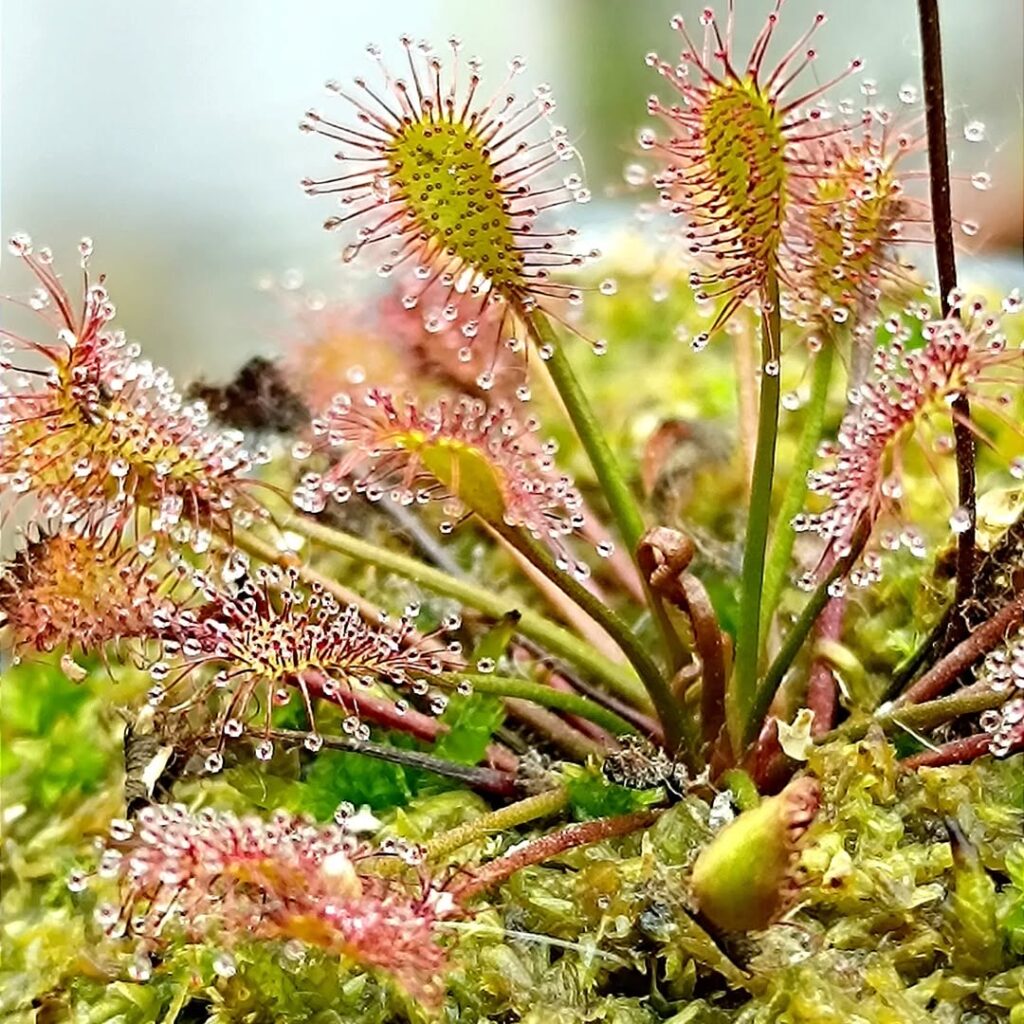
Unlike its round-leaved cousin, this sundew has elongated leaves that stretch toward the sky, maximizing its ability to catch flying and crawling insects. It thrives in wet, acidic soils and can tolerate a range of conditions, from temperate climates to subtropical regions. When it captures prey, its leaves slowly fold inward to ensure digestion.
Drosera filiformis (Thread-leaved Sundew)
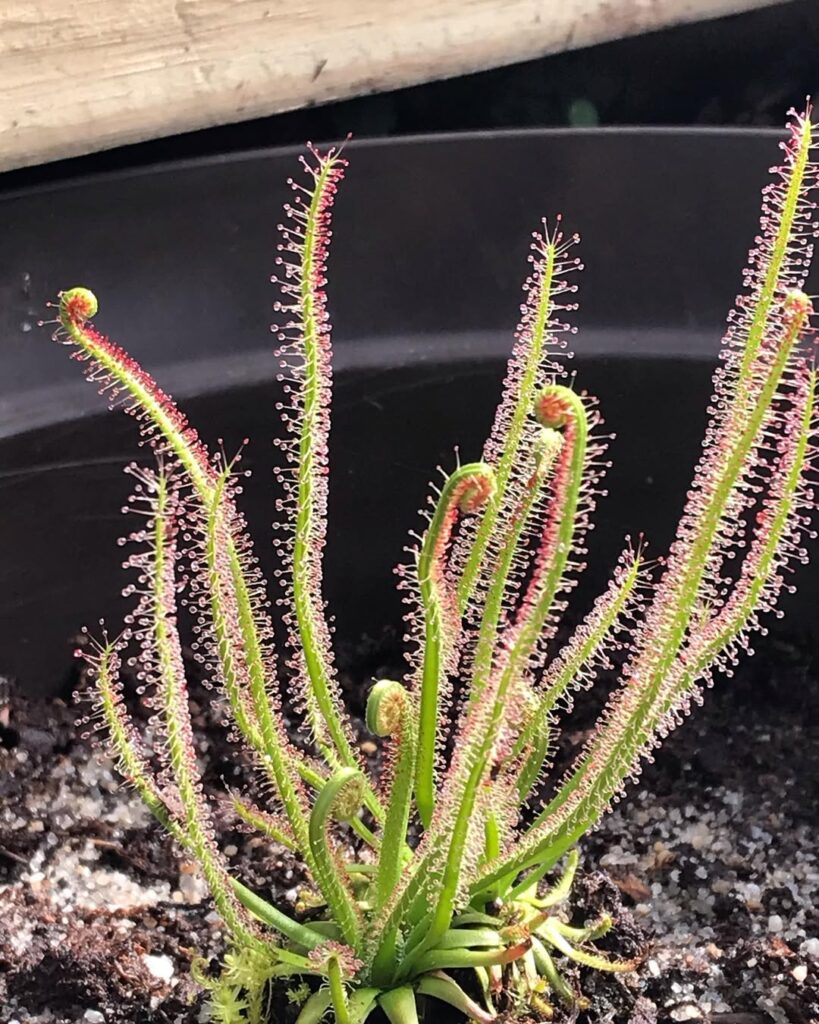
This sundew has long, narrow leaves that resemble delicate strands of grass, each coated in tiny sticky tentacles. It can grow up to 12 inches tall, making it one of the larger temperate sundews. The plant’s slender leaves allow it to trap larger insects like moths, which become entangled and eventually digested.
Drosera anglica (English Sundew)
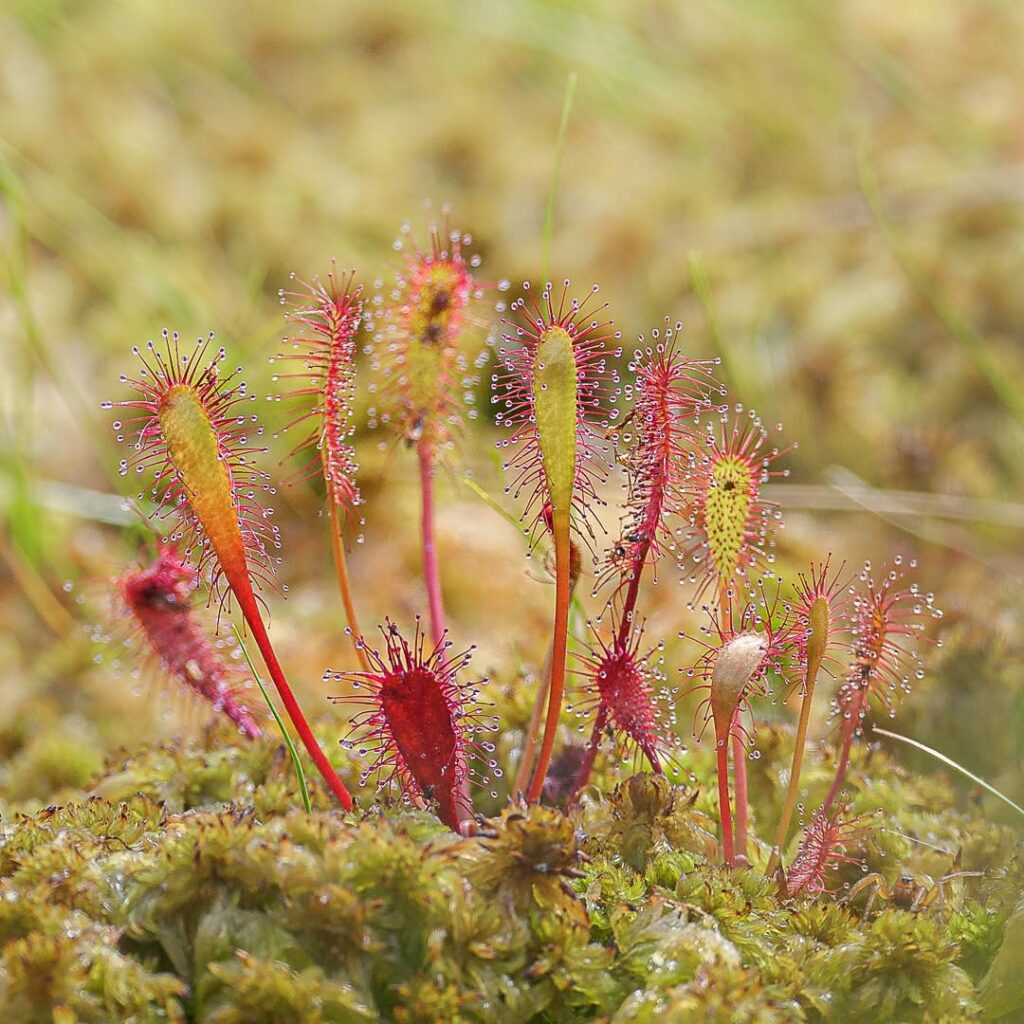
This species is the result of a natural hybrid between Drosera rotundifolia and Drosera linearis, combining features of both parents. Its elongated leaves are highly efficient at capturing insects, and its ability to survive cold temperatures makes it well-suited to northern climates. It thrives in peat bogs and other wet environments, making it a staple in temperate carnivorous plant collections.
Drosera linearis (Linear-leaved Sundew)

A rarer species, this sundew features exceptionally thin, grass-like leaves that give it a delicate appearance. Unlike other temperate sundews, its growth habit is more upright, allowing it to snare flying insects. It prefers nutrient-poor wetlands, relying solely on its carnivorous nature to supplement its diet.
Subtropical Sundews
These sundews grow year-round in warm, humid environments.
Drosera capensis (Cape Sundew)
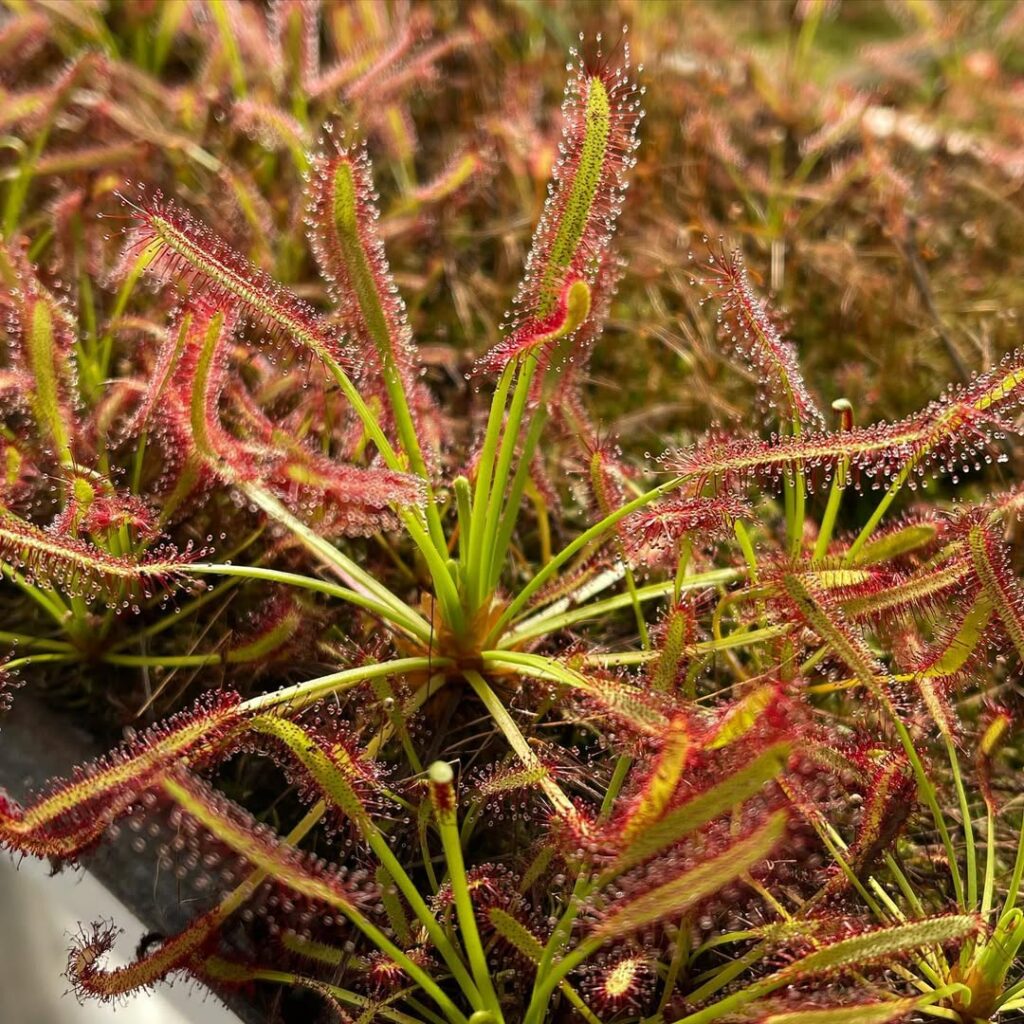
One of the most popular sundews among growers, the Cape Sundew is known for its long, slender leaves adorned with bright red tentacles. Native to South Africa, it thrives in warm climates and is highly adaptable, often growing in cultivation without much fuss. Its leaves exhibit a fascinating curling motion when digesting prey, wrapping around insects to maximize contact with digestive enzymes.
Drosera spatulata (Spoon-leaved Sundew)
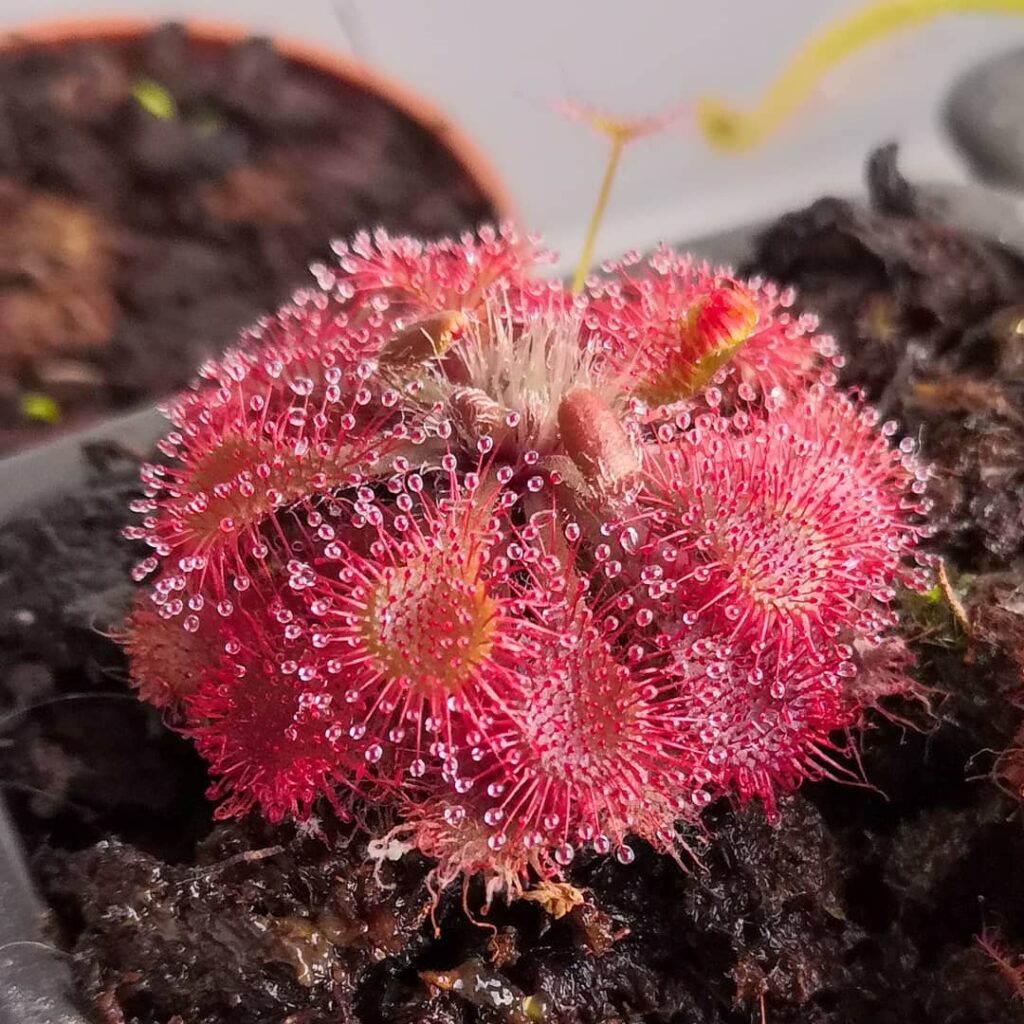
This sundew has spoon-shaped leaves that curl inward when capturing prey, creating a stunning visual effect. It is widely distributed across Asia and Australia, making it one of the most adaptable sundews available. Despite its small size, it can catch a surprising number of insects, often leaving little room on its leaves for more victims.
Drosera aliciae (Alice Sundew)
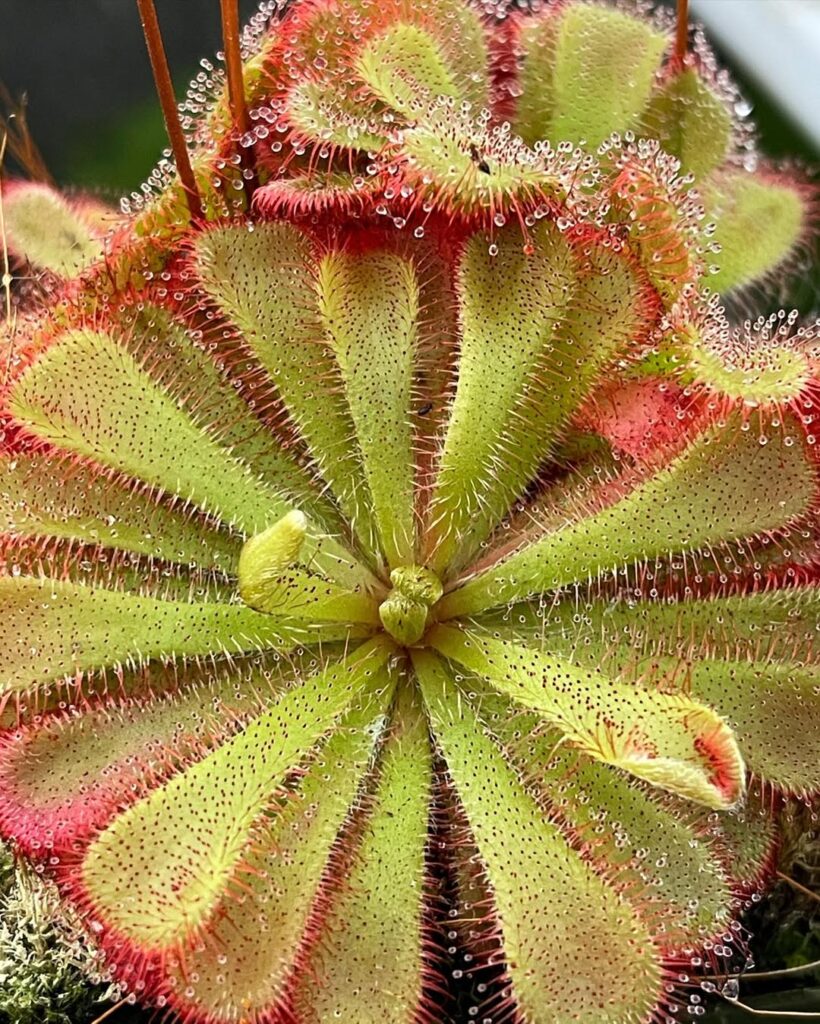
Alice Sundew forms compact rosettes with rounded leaves, each lined with tiny red tentacles. It thrives in warm and humid environments, making it an excellent choice for indoor cultivation. When catching insects, its tentacles quickly respond by bending inward, ensuring its prey is securely trapped for digestion.
Drosera burmannii (Burmese Sundew)

This fast-acting sundew exhibits rapid movement when trapping prey, often curling its leaves around insects in seconds. Found in Southeast Asia and Australia, it grows low to the ground in sandy soils, relying on its speed to outcompete other plants for nutrients. Due to its short lifespan, it produces abundant seeds to maintain its population.
Drosera natalensis (Natal Sundew)
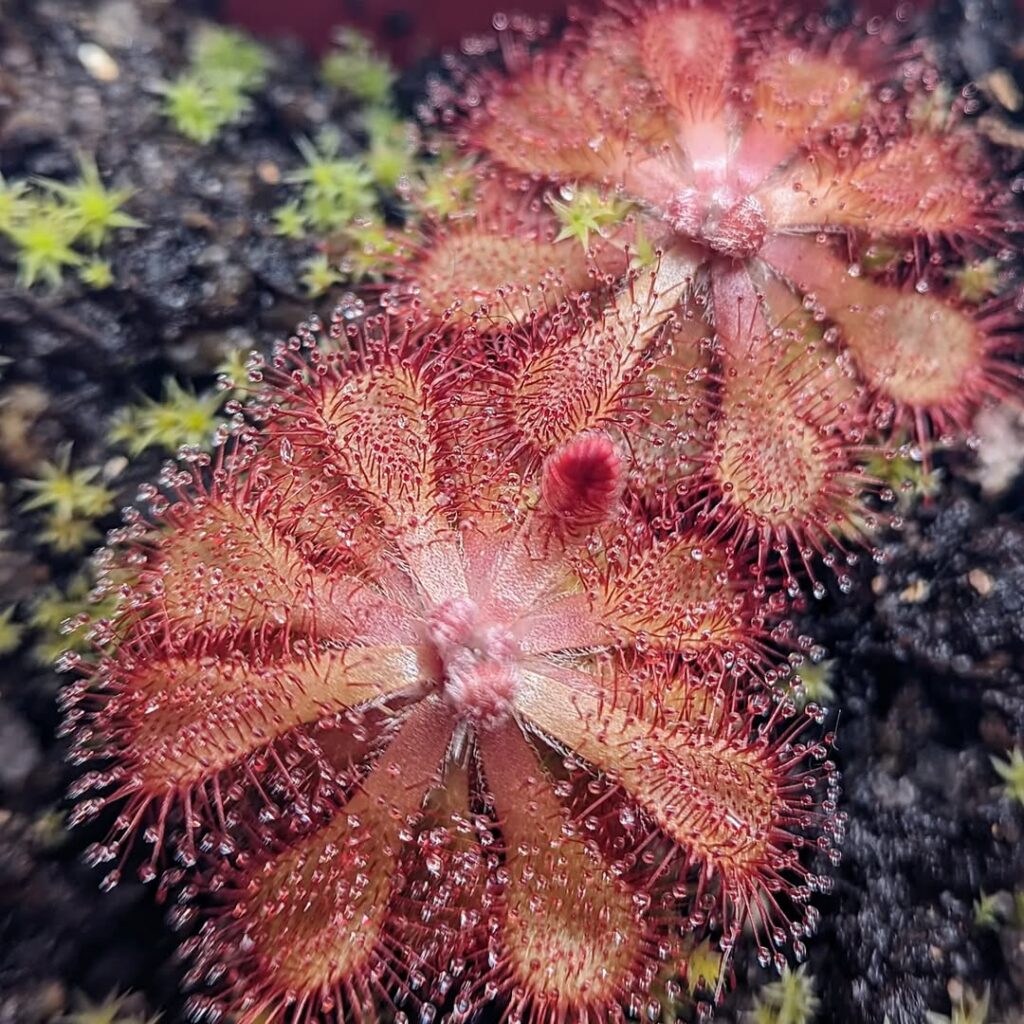
Native to Africa, this sundew has deep red leaves that make it stand out from other species. It thrives in wet conditions and is known for its ability to attract a wide range of insects. Its leaves create a sticky surface that ensures even the most persistent escape attempts are futile.
Pygmy Sundews
These tiny sundews grow in dry areas and have unique reproductive adaptations.
Drosera dichrosepala
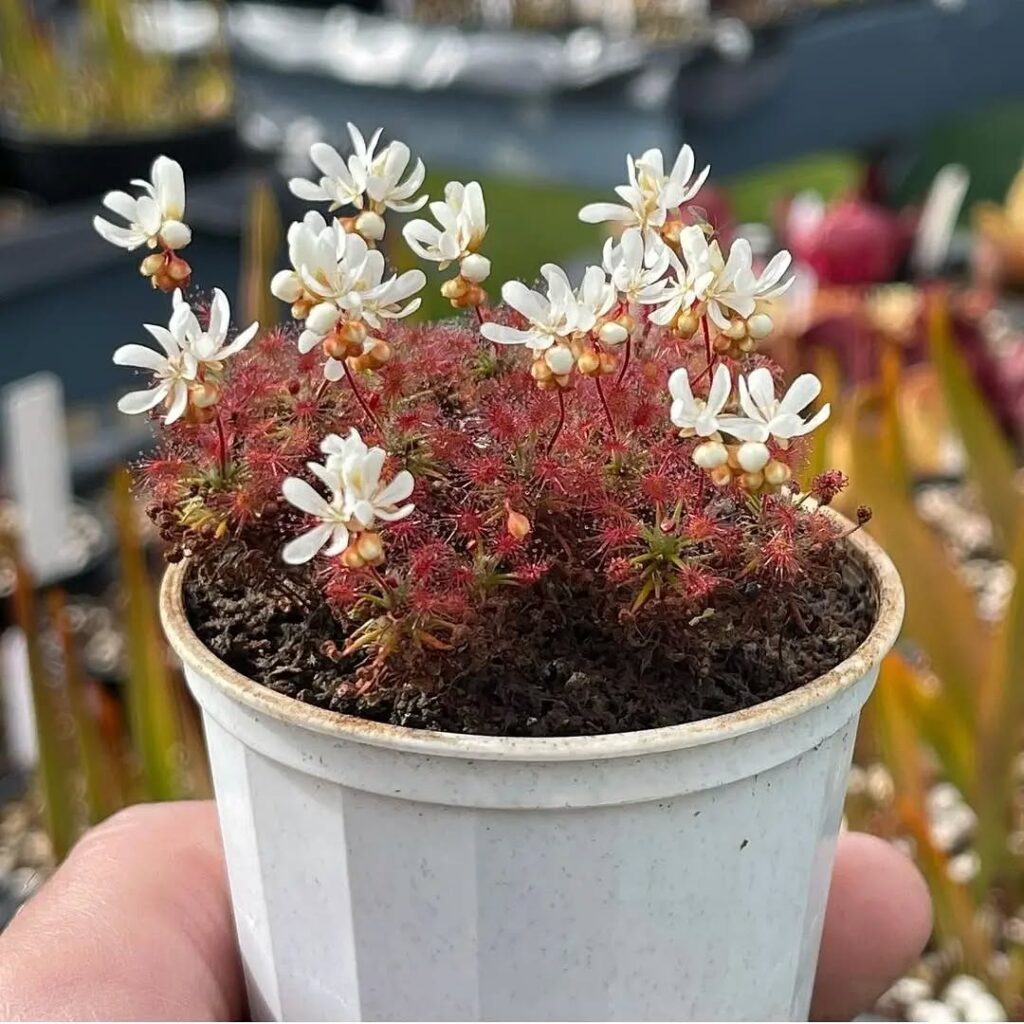
Unlike most sundews that rely on seeds for reproduction, Drosera dichrosepala produces gemmae—tiny plantlets that develop into new sundews. These unique adaptations allow it to spread efficiently in the harsh Australian climate. Its compact growth and reddish tentacles make it a visually striking addition to any carnivorous plant collection.
Drosera pulchella
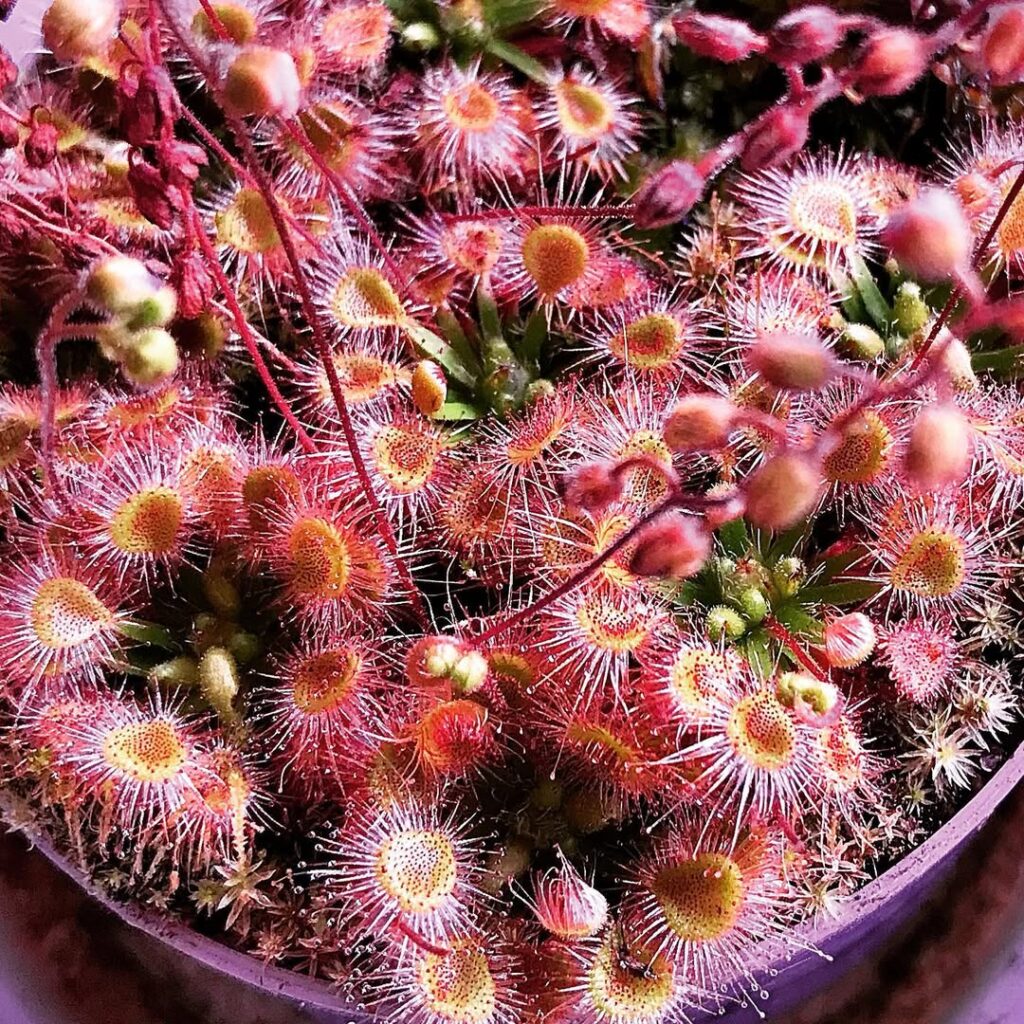
This pygmy sundew forms small rosettes with bright orange-red tentacles that glisten in the sunlight. Despite its miniature size, it’s highly efficient at catching tiny insects such as gnats and fruit flies. Drosera pulchella thrives in nutrient-poor sandy soils and requires seasonal care to maintain its health.
Drosera scorpioides
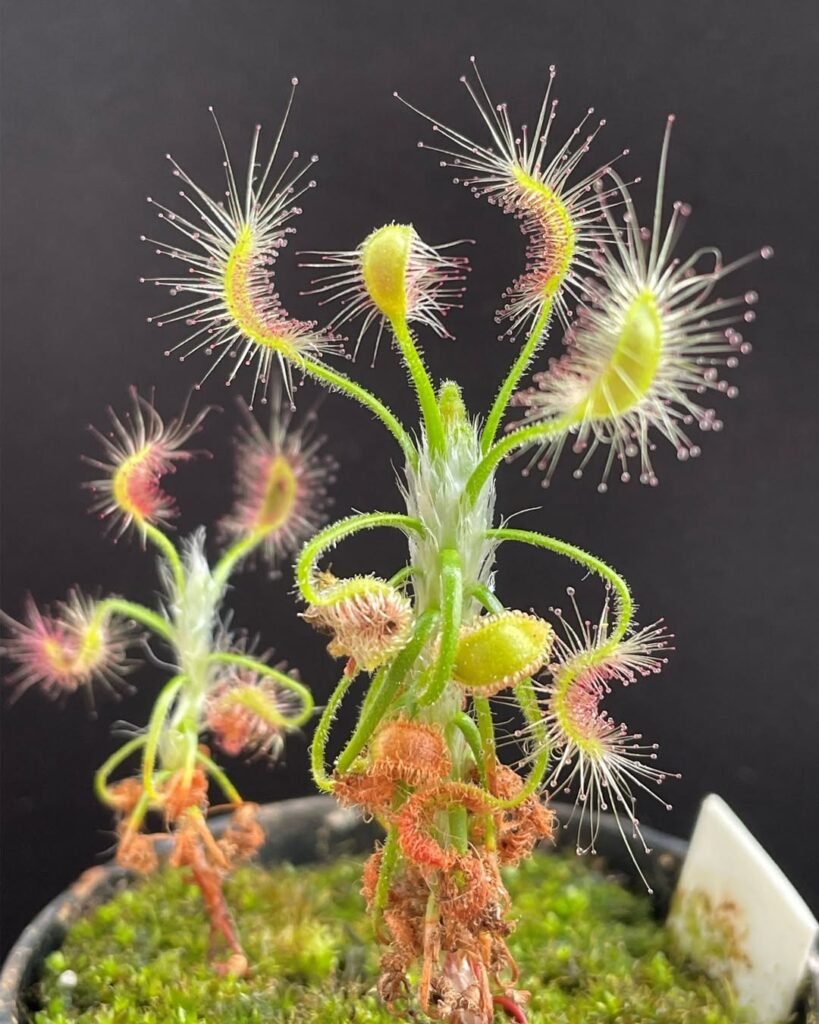
One of the most unusual pygmy sundews, Drosera scorpioides has elongated leaves that grow in a spiraled pattern, resembling the tail of a scorpion. As insects land on its leaves, they become ensnared by the sticky hairs, leading to a slow but inevitable digestion process. Its striking appearance and efficient trapping mechanism make it a favorite among carnivorous plant enthusiasts.
Drosera omissa
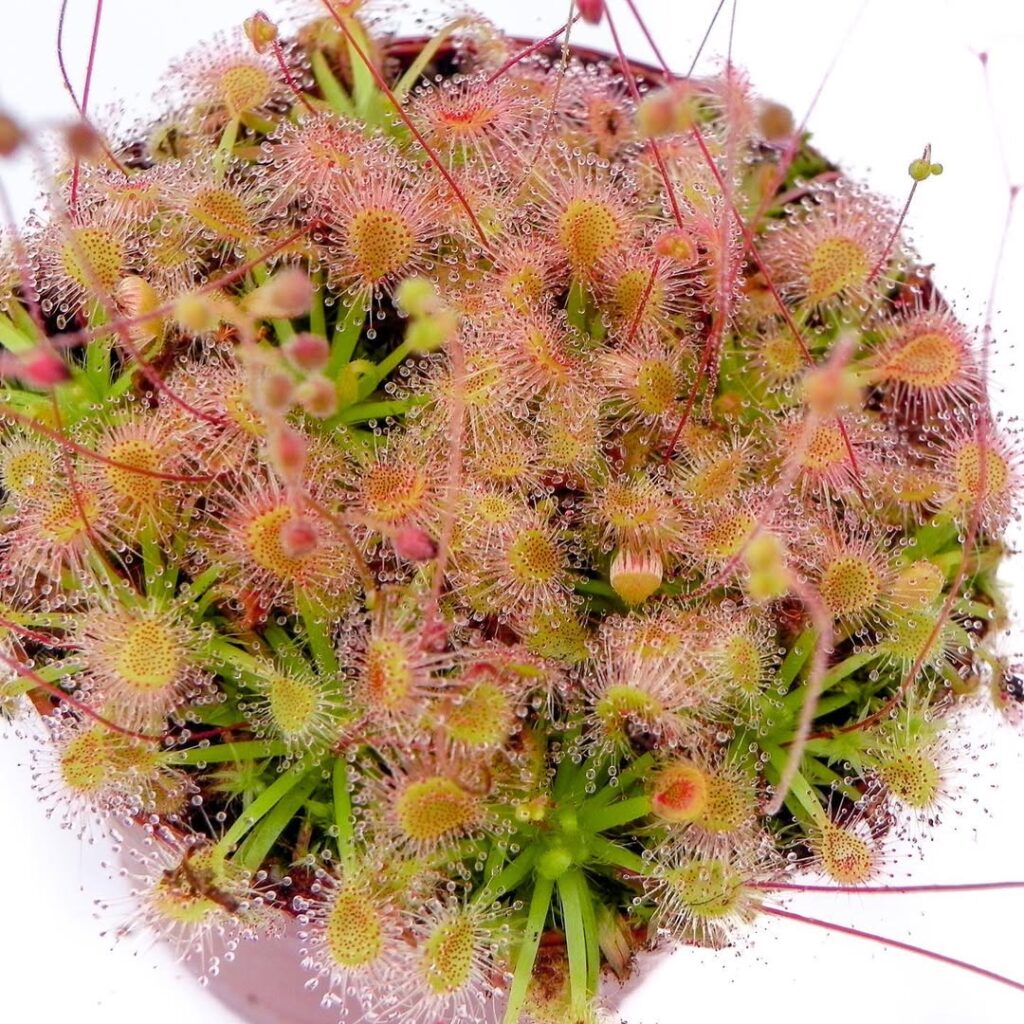
A small yet highly effective sundew, Drosera omissa produces delicate rosettes covered in fine tentacles. These tentacles are extremely sensitive, reacting quickly to any prey that comes into contact with them. Its ability to thrive in warm climates and its low-maintenance nature make it a great choice for beginner growers.
Drosera roseana
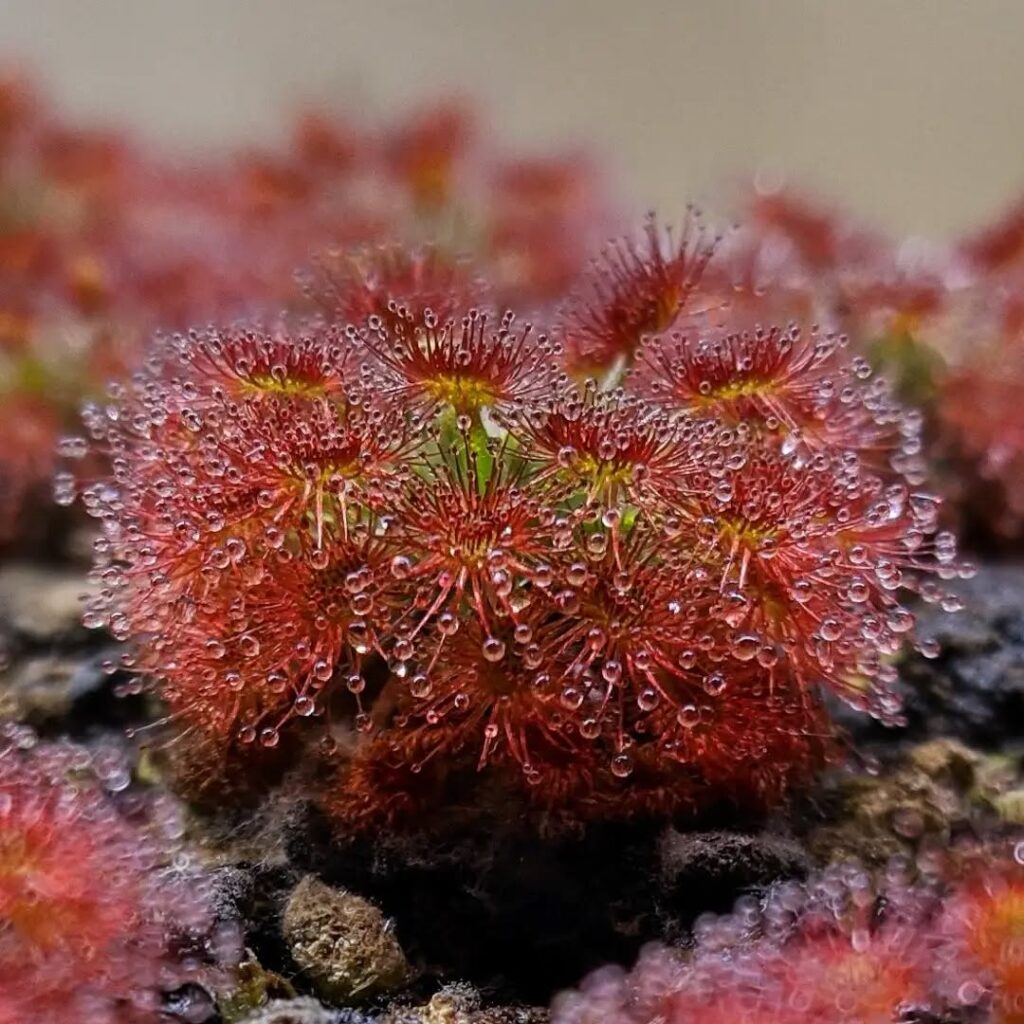
Soft pink hues set Drosera roseana apart from other pygmy sundews, making it one of the most beautiful species in its category. It remains small, forming compact clusters that can quickly spread through gemmae reproduction. This sundew is highly adaptable, tolerating a variety of environmental conditions while maintaining its vibrant coloration.
Tuberous Sundews
These sundews grow underground tubers to survive harsh conditions.
Drosera auriculata
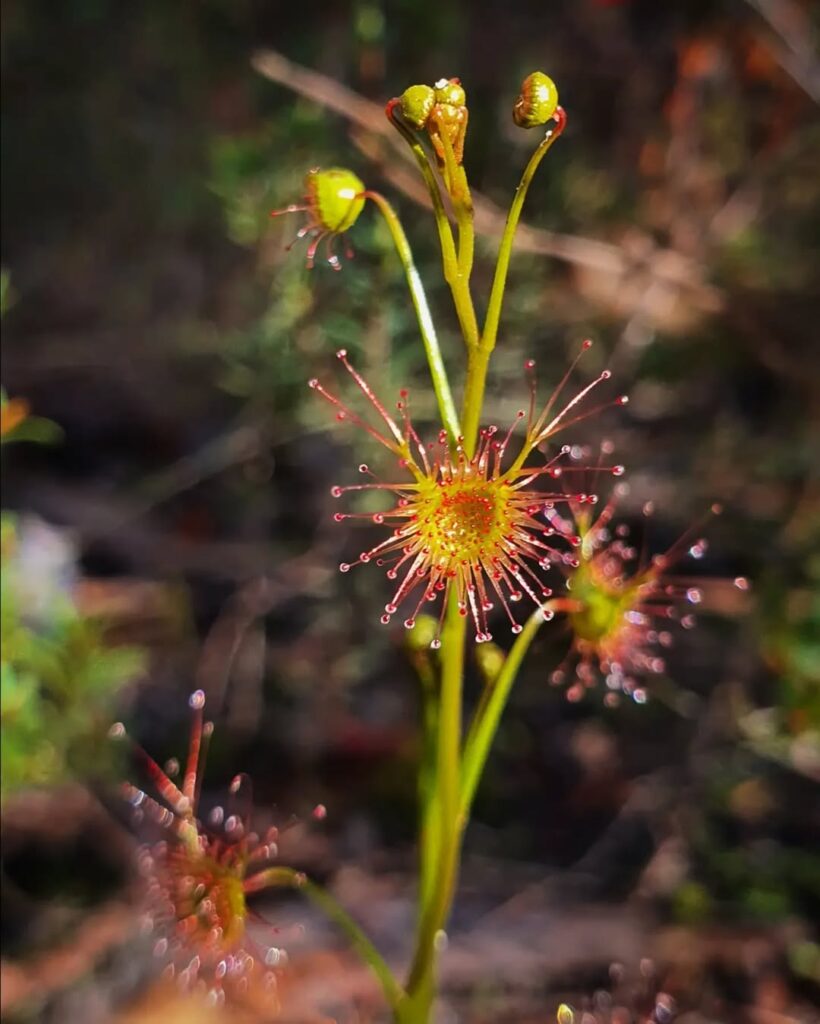
Unlike most sundews, Drosera auriculata features climbing stems that stretch toward light sources, helping it compete in taller vegetation. It uses sticky glandular hairs along its stems to trap unsuspecting insects. Found in Australia, this sundew’s climbing habit makes it a unique specimen within the tuberous sundew group.
Drosera erythrorhiza
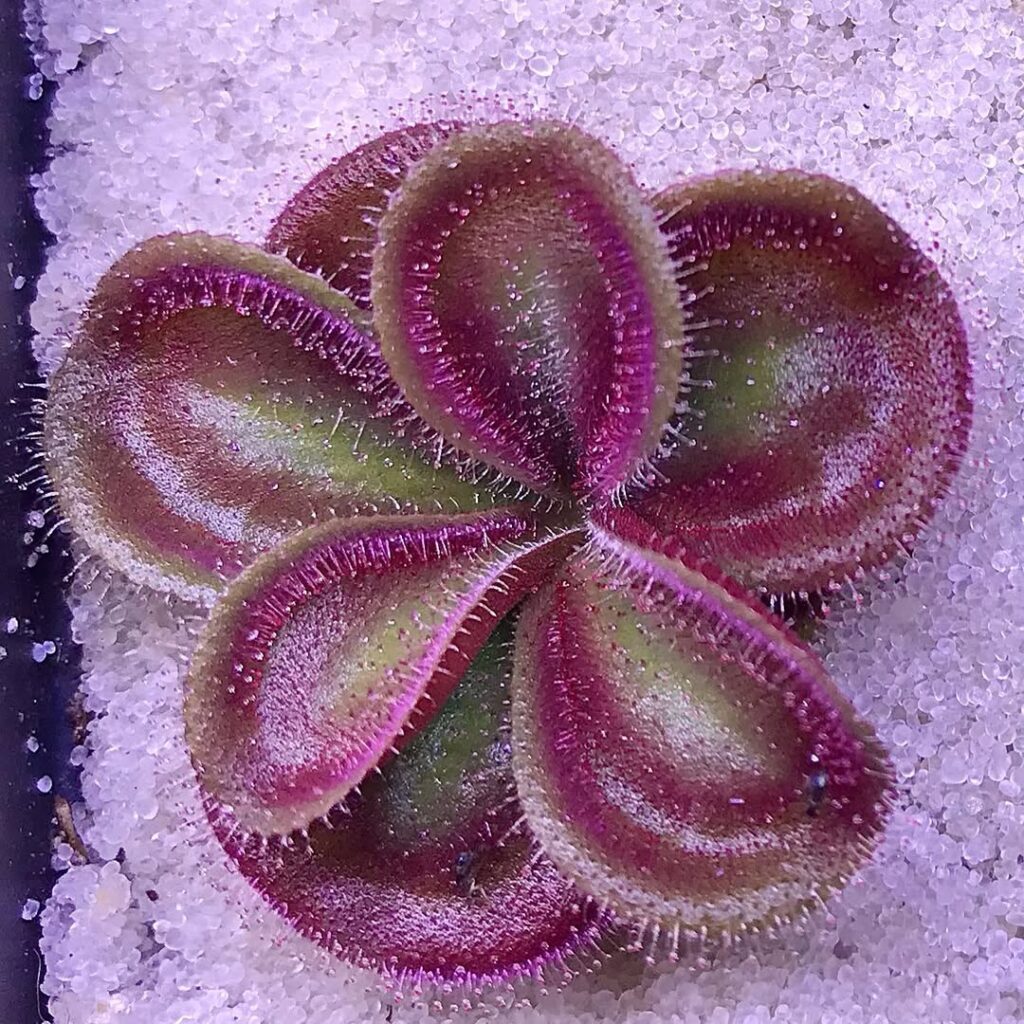
Drosera erythrorhiza emerges from underground tubers each year, producing vibrant red leaves with dense tentacles. This species is known for its ability to withstand prolonged dry seasons by retreating underground. When active, its deep red coloration enhances its visual appeal, making it a sought-after species among collectors.
Drosera gigantea
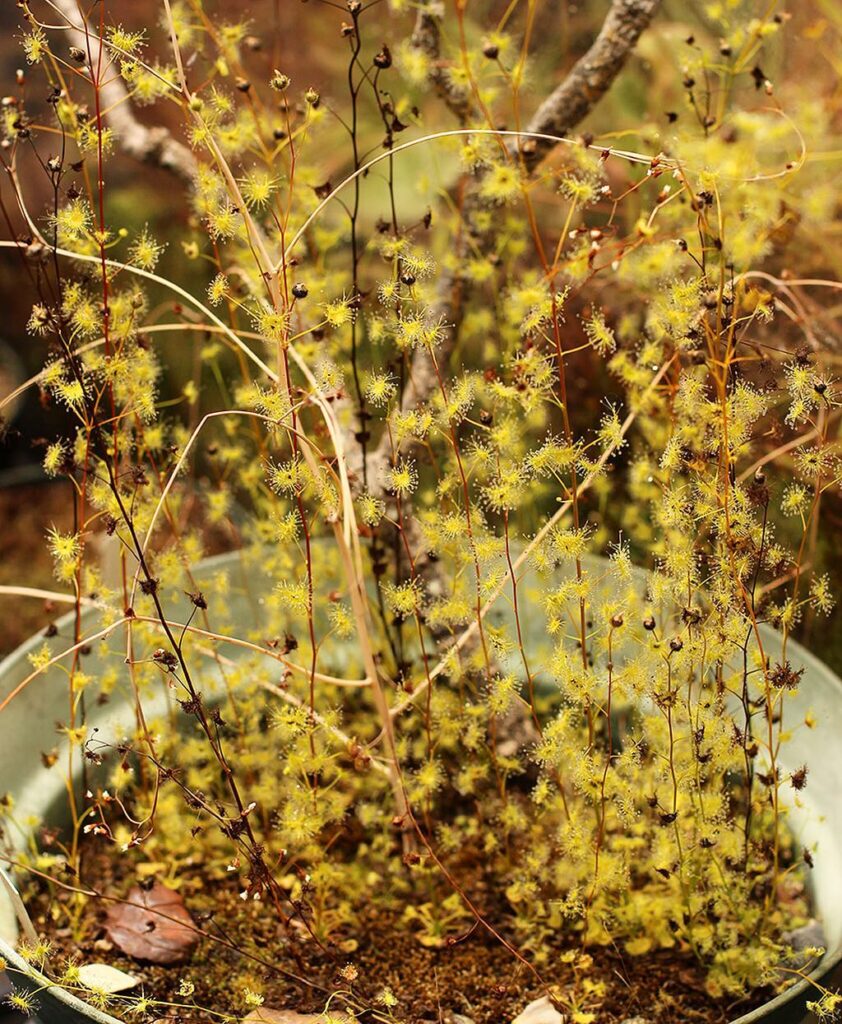
As one of the tallest sundews, Drosera gigantea earns its name with towering stems that resemble small trees. This sundew can reach heights of over three feet, with numerous branches covered in sticky traps. It thrives in sandy environments and relies on underground tubers to survive periods of drought.
Drosera macrantha
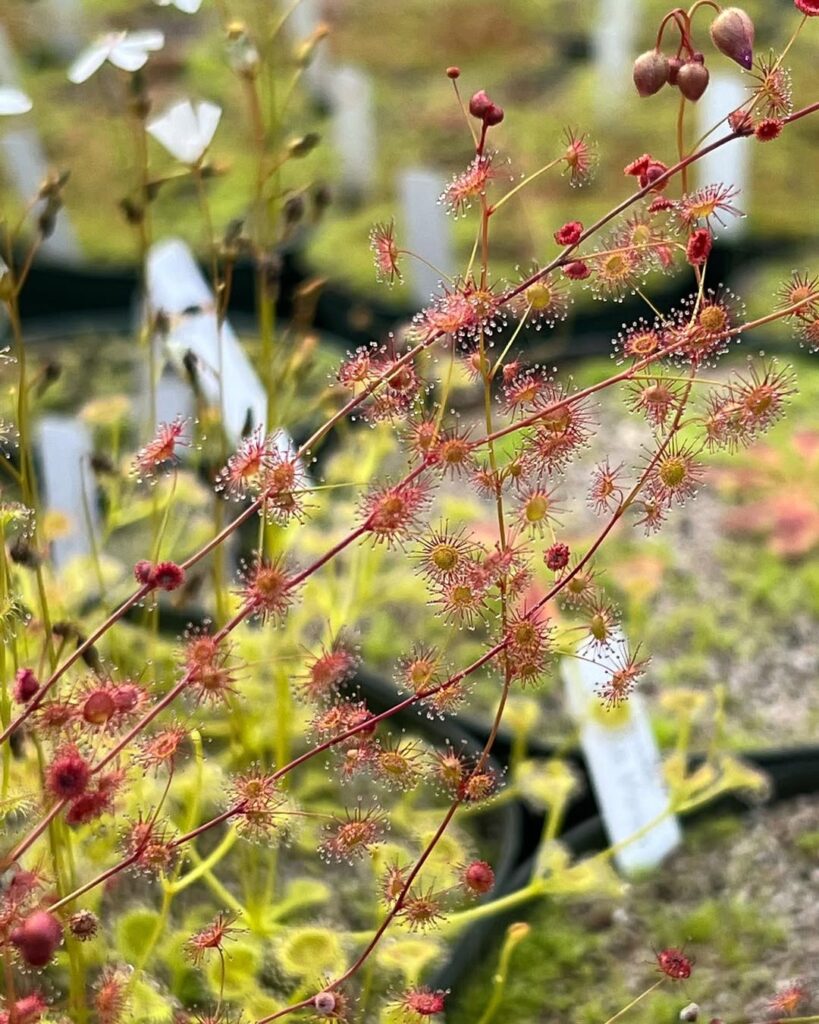
Drosera macrantha grows as a climbing vine, using its sticky traps to secure itself while capturing passing insects. It produces delicate white or pink flowers, adding an ornamental charm to its carnivorous nature. Its ability to grow vertically sets it apart from most sundews, making it a fascinating addition to any collection.
Drosera peltata
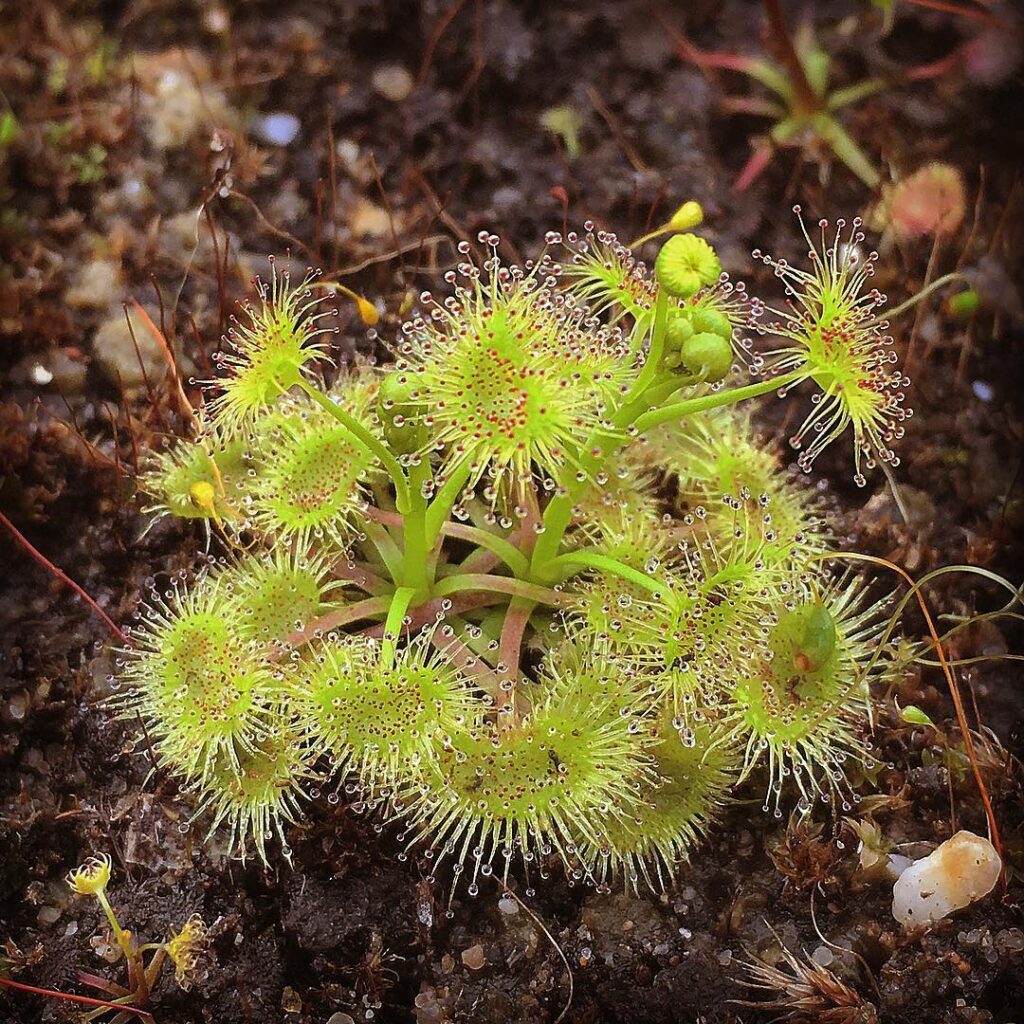
This hardy sundew survives by forming underground storage tubers that allow it to regrow each season. Drosera peltata is highly adaptable, thriving in various conditions from arid landscapes to subtropical forests. Its striking yellow-green leaves give it a distinct appearance, while its trapping mechanism ensures it remains well-fed throughout its growth cycle.
Petiolaris Complex Sundews
These sundews grow in extreme heat and adapt to dry conditions.
Drosera petiolaris
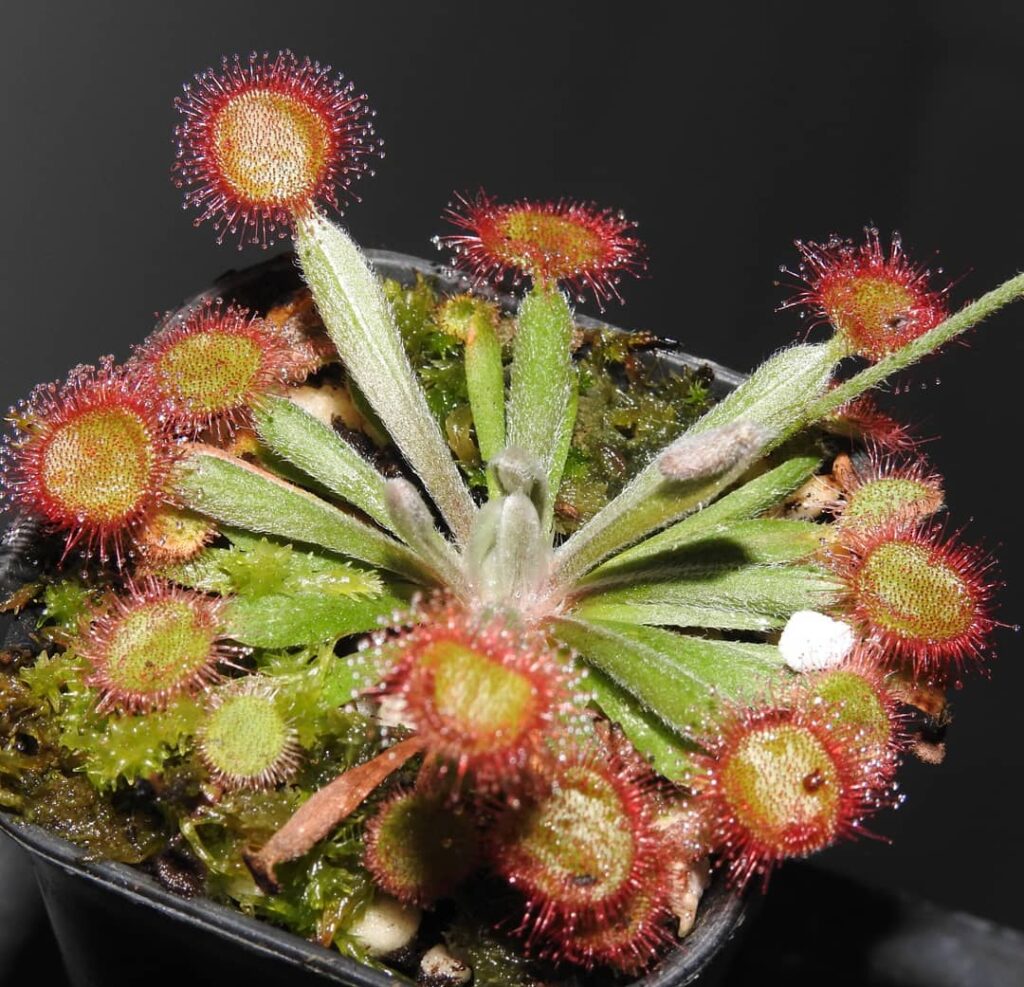
Drosera petiolaris has evolved fuzzy, elongated leaves that help conserve moisture in the scorching climates of northern Australia. Unlike most sundews with slick, glistening surfaces, this species uses fine hairs to regulate water retention. Despite its adaptations, it remains an efficient predator, trapping and digesting insects with ease.
Drosera paradoxa
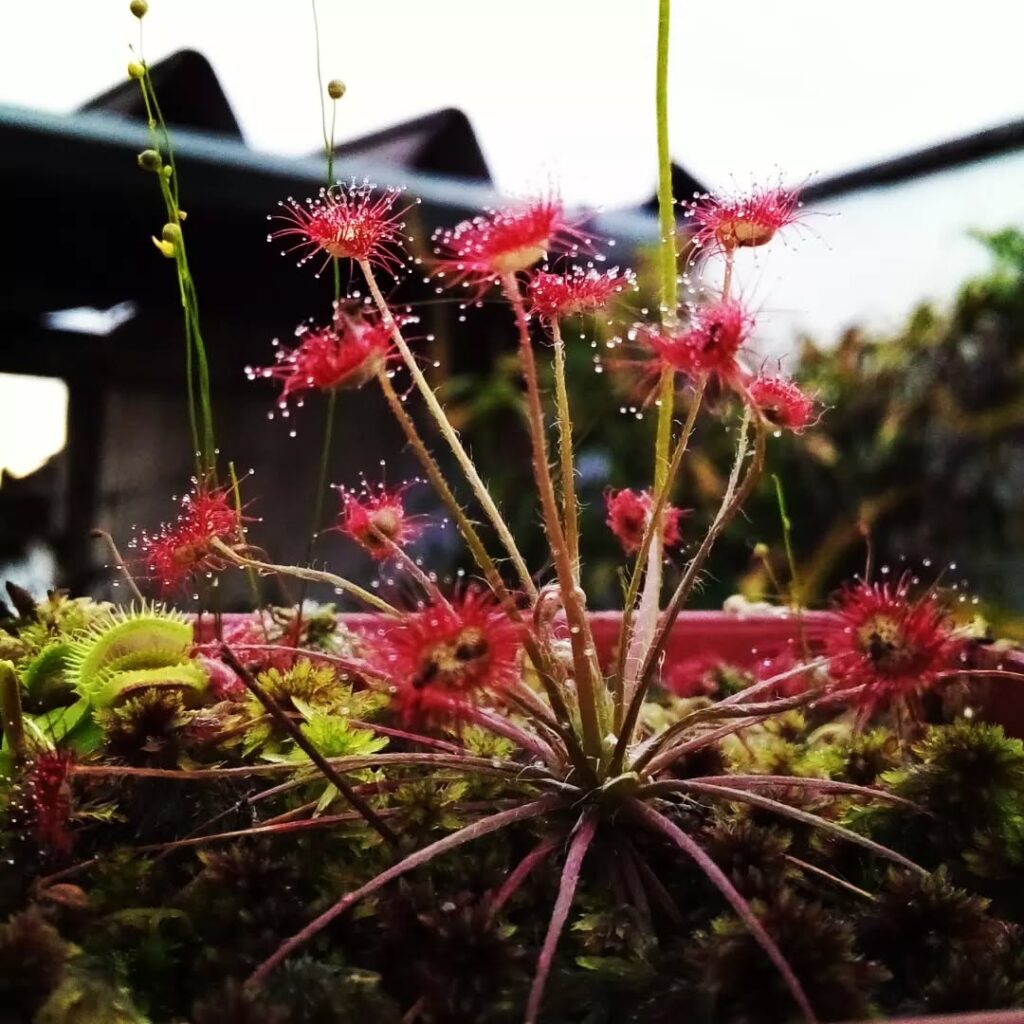
With its broad, paddle-like leaves, Drosera paradoxa maximizes its ability to catch insects in harsh environments. It thrives in tropical regions, where sunlight is intense, and humidity is low. This sundew is known for its resilience, surviving in conditions that would be challenging for most carnivorous plants.
Drosera kenneallyi
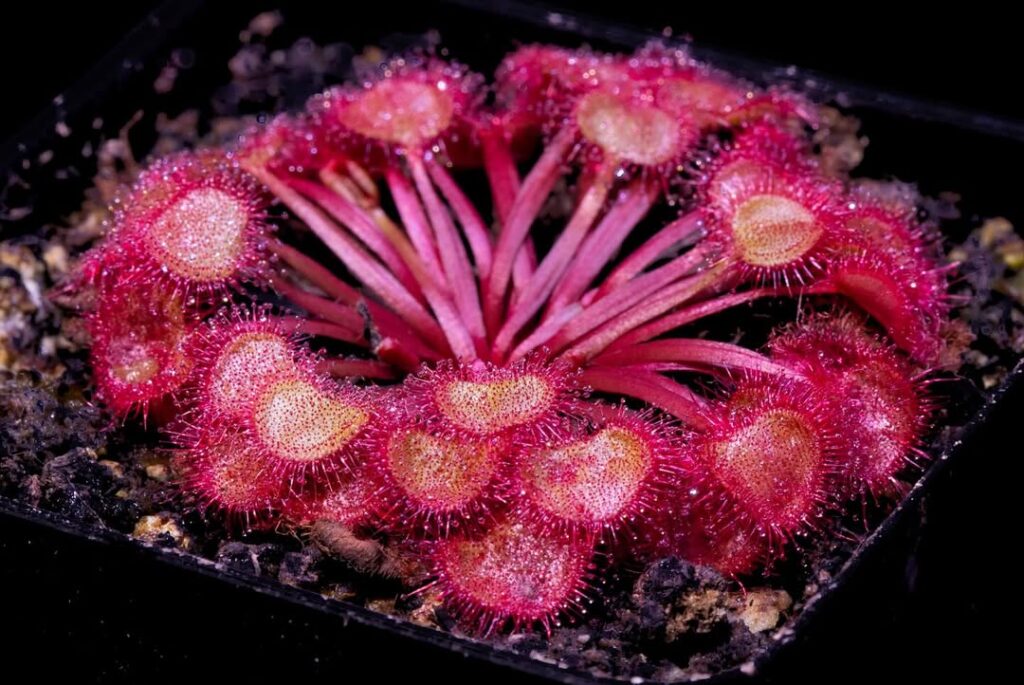
A rare sundew found in Australia’s arid regions, Drosera kenneallyi grows in loose sandy soil where few other plants can survive. Its compact growth allows it to conserve water while remaining an active predator. Its tentacles react quickly to trapped prey, ensuring a fast digestion process.
Drosera lanata
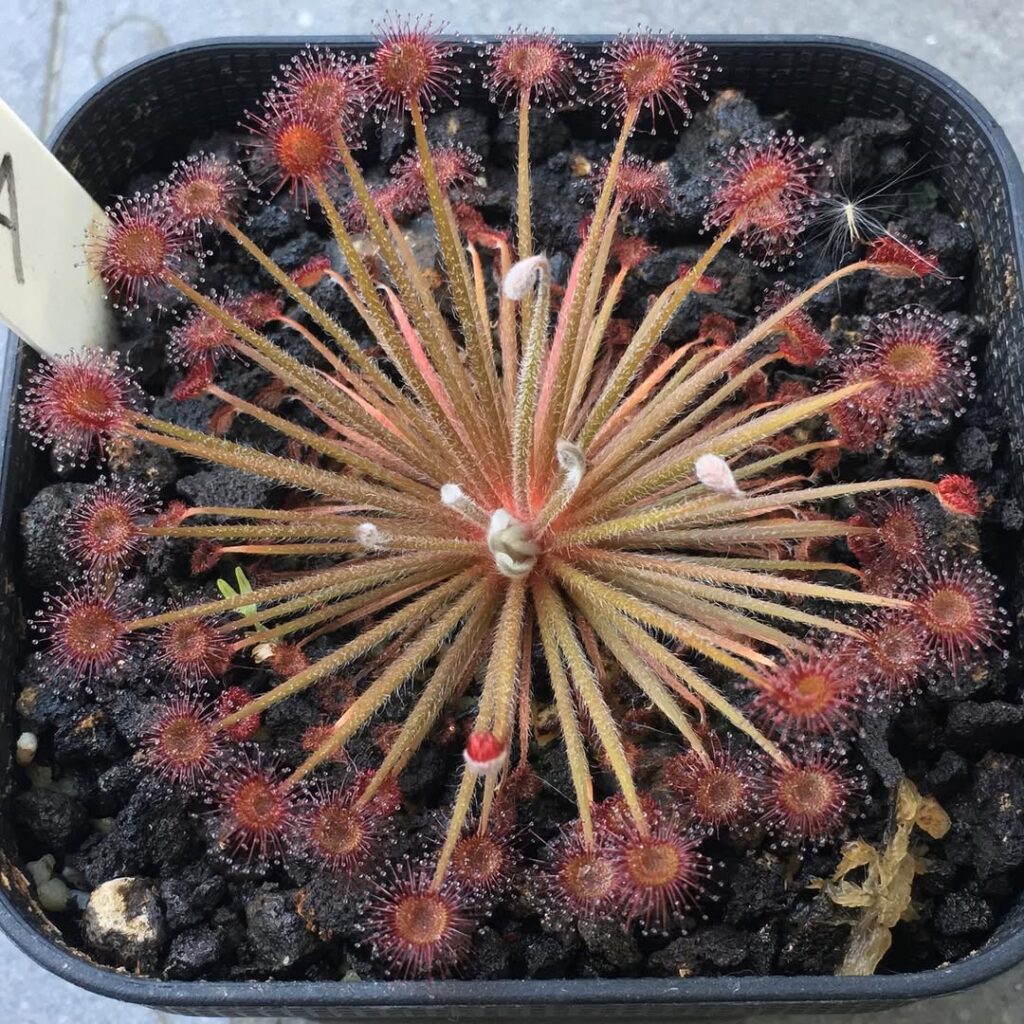
Fine white hairs cover the surface of Drosera lanata’s leaves, helping it endure extreme temperatures. The fuzziness of this sundew is not just for show—it significantly reduces water loss by trapping humidity around the plant. Despite its adaptations for survival, it remains an excellent hunter, capturing small insects with its sticky tentacles.
Drosera dilatato-petiolaris
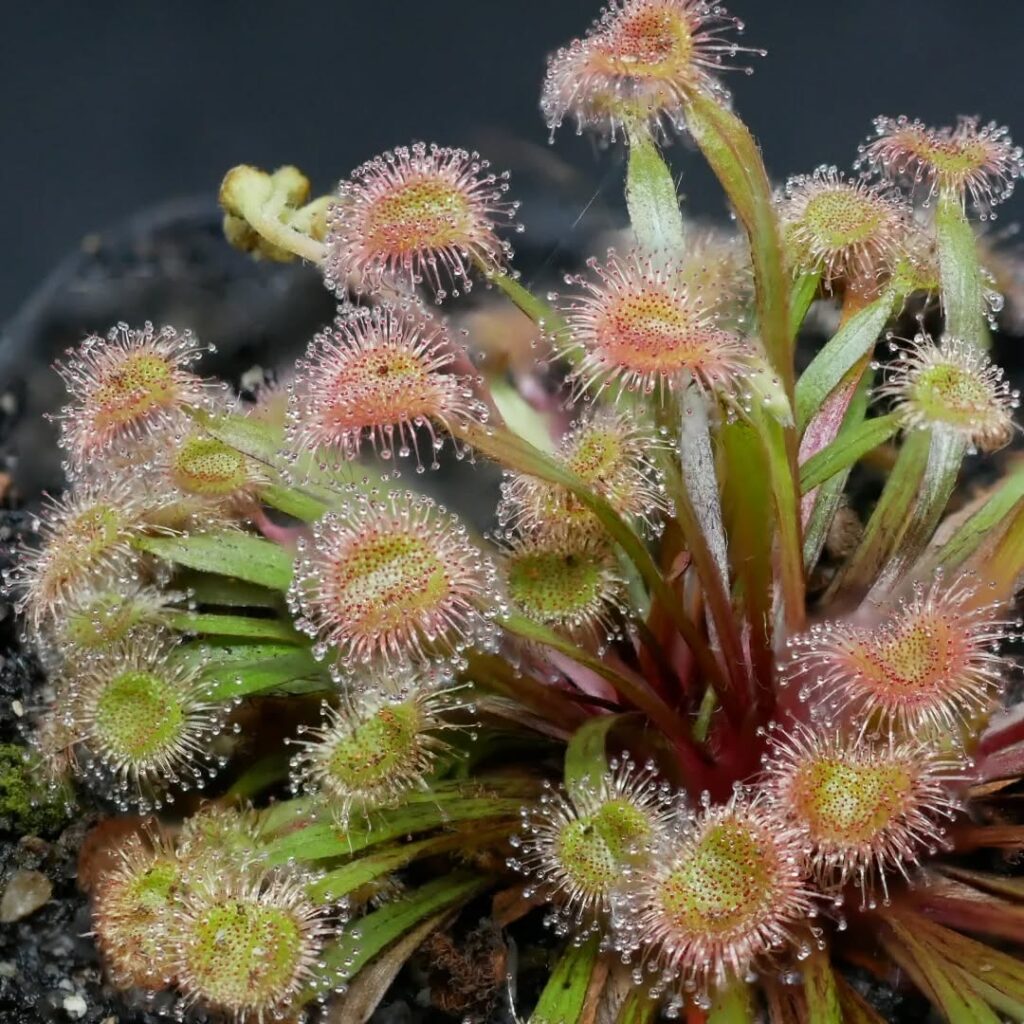
This sundew produces large, rounded leaves with abundant sticky traps, making it one of the most effective insect catchers in its category. It thrives in hot, dry climates, using its broad surface to absorb as much sunlight as possible. Its ability to withstand extreme conditions makes it an impressive and resilient carnivorous plant.
Final Words
Sundews are more than just insect-eating wonders—they showcase the power of adaptation and diversity in the plant world. Whether you’re drawn to their unusual beauty or their carnivorous nature, these plants never fail to intrigue. Which type of sundew would you want to grow?
